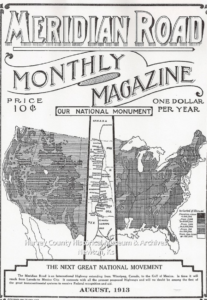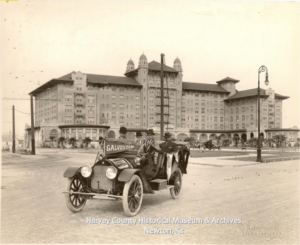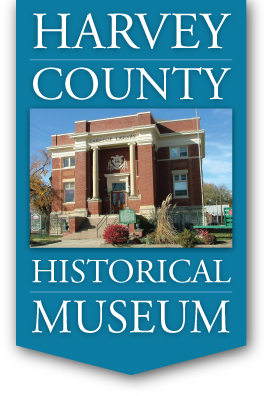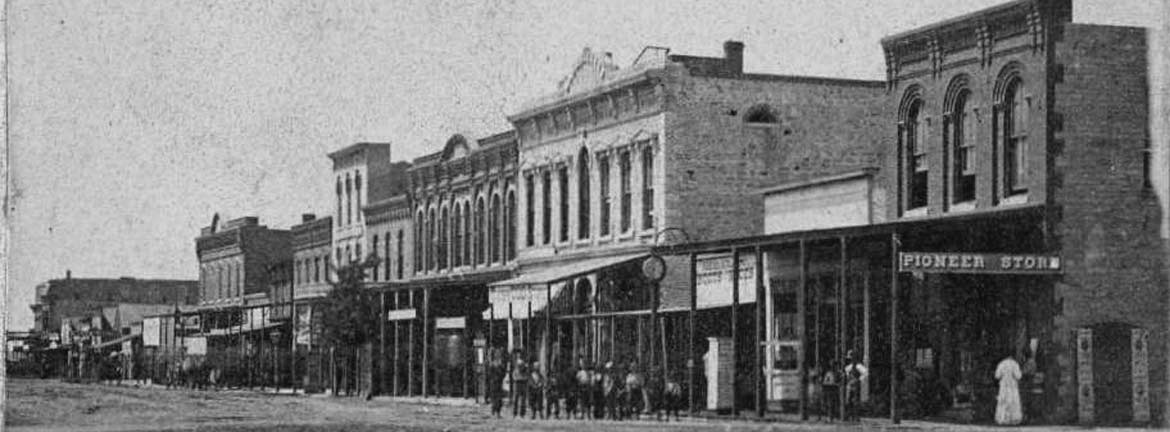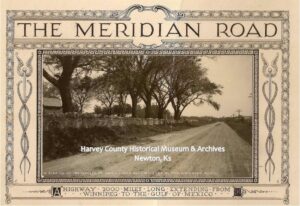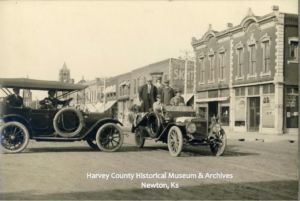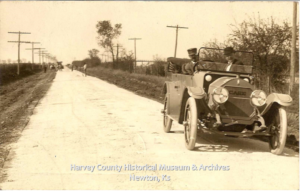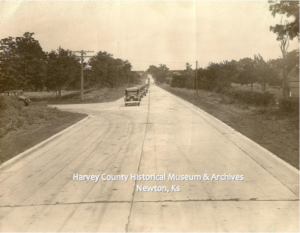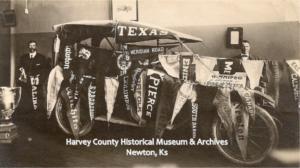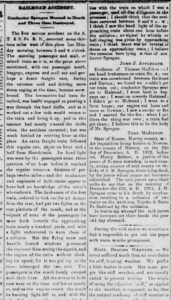by Kristine Schmucker, HCHM Curator
Today, it might be hard to imagine the cheering crowds and the pounding of hooves on a dirt track speeding around the circle drive at Athletic Park, but in 1897, a horse racetrack was one of the primary purposes of Athletic Park. The paved round drive around the park is a remnant from that long ago time.
“Athletic Park A Go”
“The object of the association shall be to own real estate and provide and maintain a park for public gatherings, driving bicycling, baseball, foot-ball, gun club, boating, bathing and other innocent sports and amusements.” (Newton Kansan, 2 September 1897)
The park was a project of the Commercial Club and was established in fall 1897. The park was 40 acres with a dam for Sand Creek. Also included was a “half mile regulation horse track and inside of this a regulation one third mile bicycle track.” There were stables with ten box stalls, and additional stables were added over the years. The addition of a baseball diamond and grandstand made it “one of the most complete athletic parks in the country.” (Newton Kansan 12 August 1897)
There was a great deal of pride in the new park and especially the racetrack. On March 31, 1898, the editor of the Newton Kansan declared that Newton was “To Be A Great Horse Town!” With the new facilities, Newton had “good prospects of being the horsiest town in central Kansas.”
“Horsiest Town in Central Kansas”
Several local men owned and raced horses including Samuel Lehman, Dr. J. T. Axtell, and Jack Kraus. In addition, some well-known horse trainers worked in Newton including Vandever, Barron and Moore in 1897 – 98. The editor reported that Vandever was training eight horses for Dr. Axtell and eight for Fox Winnie in addition to several others. Barron was working with horses belonging to W.G. Pearson, John Bender and George Schell, noting that “these goers are expected to make a record this summer.” Moore came from McPherson will train horses belonging to S.P. Byers, F.S. Steinkirchner, Conductor Ferfuson, J.A. McGaughey and Dr. Boyd.
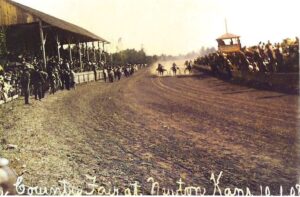
Managing the track was the responsibility of Giles Smith. By May a rule was created giving Smith “complete control” of the park and especially of the track. Due to changing weather conditions, no one was to use the track without a permit from the president of the organization, Dr. J.T. Axtell or the secretary, J.C. Nicholson. Even with a permit, Smith still had the authority to refuse use of the track. (Newton Kansan, 5 May 1898)
“Famous Horses Here”
“It is reported that a race has been matched between Fred Rowland’s black “Kidnapper” mare and Henry Steinkirchner’s gray “McGrego” mare. The “dough” has been put up on each side, and the contest promises to be quite lively.” (Newton Kansan 31 March 1898)
In 1903, the Newton Kansan reported that Athletic Park has been a favorite place for training race horses with the horse owners of central and southern Kansas.” The horses trained in Newton in the spring and summer, then in the fall went on the circuits in either Missouri, Oklahoma, or the Arkansas Valley circuit at Hutchinson. The Arkansas Valley circuit included horses from Hutchinson, Wichita and ElDorado.
In November 1907, the Newton Kansan announced that there would be “Famous Horses Here.”
“”For twenty-four hours yesterday, Newton was the location of two of the most famous horses in the world. Dan Patch, the famous pacing stallion . . . and Cresceus, who holds the stallion trotting record.” The horses were travelling from Phoenix, AZ to Milwaukee, Wis and needed a break from the train.
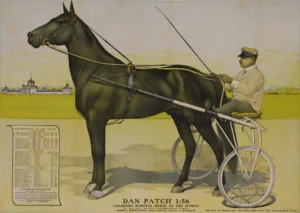
Dan Patch
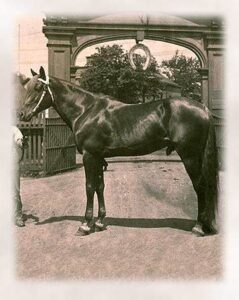
Crocseus
“Local horsemen . . . flocked to the park but were not allowed to look at the famous animals, it being the wish not to disturb the animals.”
“Playing Smash with the State Record”
The races at the county fair in September of 1906 were particularly exciting as a state record was on the line.
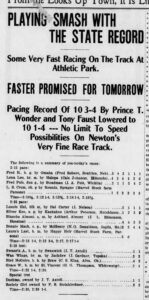
Evening Kansan Republican, 27 September 1906
The front page of the September 29, 1906 Newton Kansan proclaimed “Castlewood paces mile heat in 2:09 1/4. ” Going on to note that “the crowd was hardly prepared for such a burst of speed and their enthusiasm was nearly equal to that of the horsemen.” G.J. Thomas, Waterloon, was Castlewood’s owner. The world record set by Dan Patch September 8, 1906 was 1.55 for the mile. A record that has been equaled once but never broken. Castlewood’s time of 2:09 1/4 was a record for Kansas.
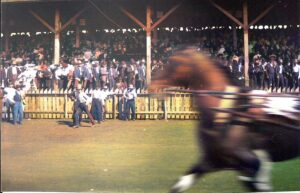
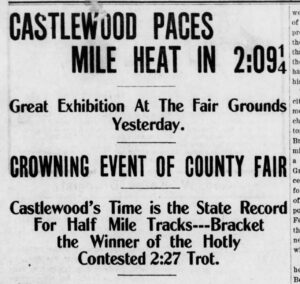
Evening Kansan Republican, 29 September 1906
Beat the Heat at the Races!
To encourage people to come to the park to watch the races, racing matinees were started in 1902. Every Friday beginning at 2:00 pm, it was free to watch the races. There were twenty plus horses in training and the writer promised “nearly all of them are speedy. “
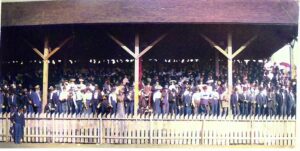
On July 20, 1905, the editor of the Newton Kansan encouraged people to go to the race matinee, noting it was “as cool there as anywhere . . . it’s so hot there is little doing in the trade and many merchants . . . do not hesitate to take a few hours off and enjoy the sport the races at the park afford.” He assured his readers that “the breezes have full play at Athletic Park and if there’s any coolness . . . you will feel it there.”
Newton Driving Club
The Newton Driving Club was established in the spring of 1905. They also planned to use the track by extending the fence around it to give room for automobiles. Friday afternoon matinees were also planned. Many of the same men were involved in both horse racing and the driving club. At the same time, a new barn with fourteen stalls was constructed at the park.
The regulation bicycle track was also well used.
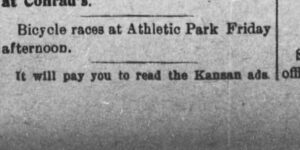
Evening Kansan Republican, 30 August 1899
The Harvey County Fair
On December 24, 1904, the Newton Kansan reported that the Athletic Park and County Fair Association Agree on Terms.”
For several years the Harvey County Agricultural Society held the county fair at the Athletic Park. The agreement gave the privilege to the fair association to rent the grounds necessary to erect barns and stalls, at their expense, and to hold fairs at Athletic Park. The track and grandstand would only be available during the fair. The Athletic Park Association received compensation of ten per cent of the profits from the fair.
“A reminder of what Newton once possessed.”
In July 1909 came the disappointing news that the county fair would no longer be held. All of the buildings at Athletic Park were sold. The stated reason included poor attendance in recent years and “no disposition on the part of the farmers to help out by bringing in their best livestock . . .the result being that the exhibits were very tame.” In addition, there were not enough horses entered in the races, “eliminating one of the main attractions of the fair.” (Newton Kansan, 15 July 1909)
In August, the grandstand was torn down, the Newton Kansan editor noted “the spot at the Park where the old grand stand stood is a sorry looking sight now and serves only as a reminder of what Newton once possessed.” (Newton Kansan, 14 August 1909)
In November, a special election was held on the question of the City of Newton buying Athletic Park. 
The vote for the proposition of the city issuing bonds of $5,000 to buy Athletic Park was largely in favor. The disappointment of the editor comes through as he noted that “there was not particular excitement, as it seemed a foregone conclusion . . . and fully half of those who were registered did not vote.” (Newton Kansan, November 1, 4, 17, 1909)
It was the end of an era. Twelve years of exciting horse races, fairs and other activities, now it was time to reimagine what would be next for Athletic Park.
